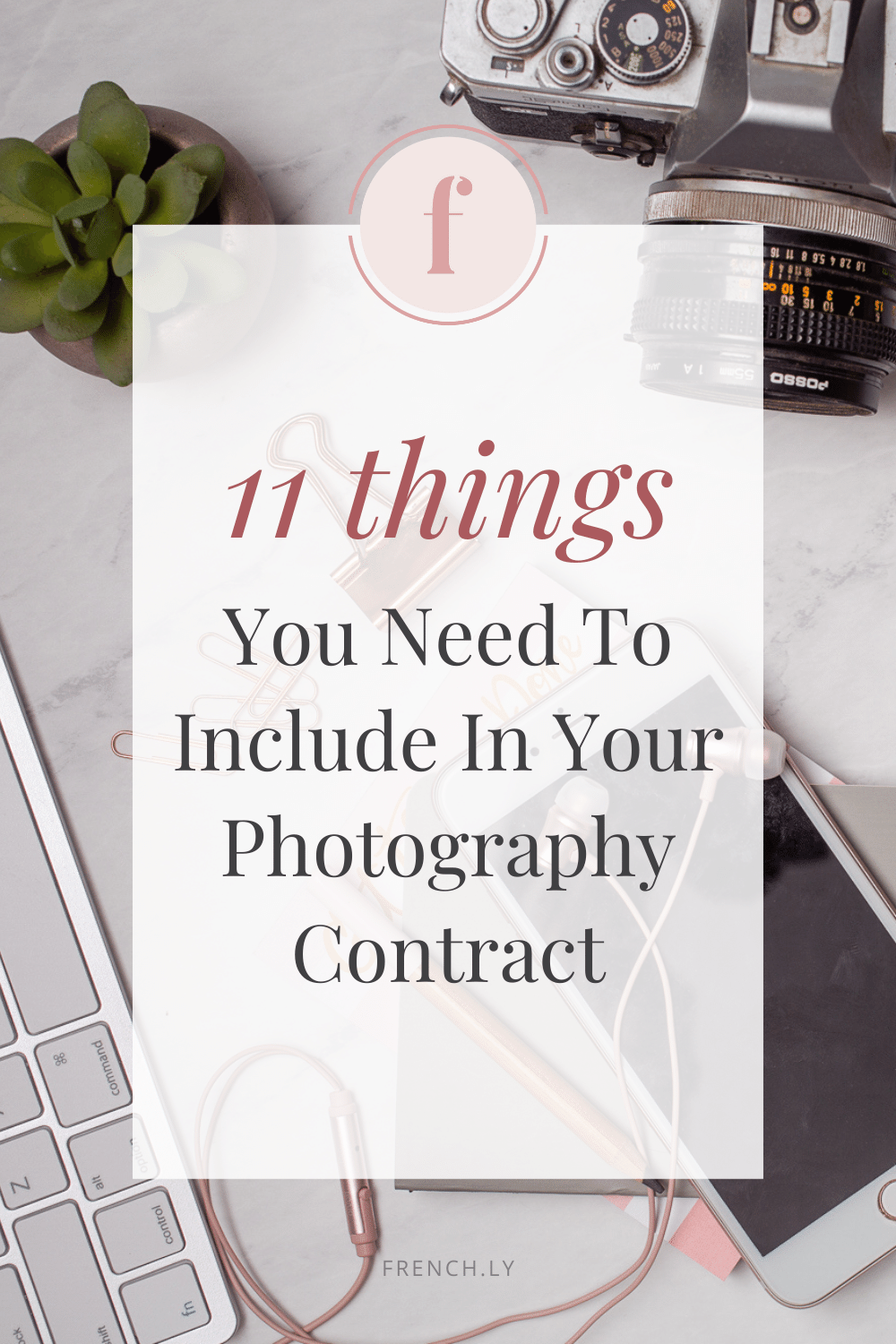In this guide, I show you how to choose who to pitch, how to find the right contact information, and how to craft a winning pitch.
PITCHING TO BRANDS AND IS THE BEST WAY TO GET YOUR IDEAL CLIENTS, AND YOU CAN DO IT WITHOUT FEELING ICKY
Gimme the Guide!
11 FOOD PHOTOGRAPHY DOCUMENTS EXPLAINED
Top Posts
11 PLACES TO SOURCE AFFORDABLE PHOTOGRAPHY PROPS AND BACKDROPS
30+ FOOD STYLING TIPS TO ELEVATE YOUR FOOD PHOTOGRAPHY
Free Resource
About Frenchly
I am a food + product photographer & educator specializing in eco-friendly and sustainable brands. When I am not working with clients, I empower creatives to start their journey by sharing my knowledge on the business of food + product photography.
11 Things You Need to Include in Your Photography Contract
February 23, 2022
Whether you are an experienced photographer or new behind the lens, you should take time to perfect your photography contract before using it with your clients. There are many advantages to using a photography contract, but only if you write it up correctly!

What is a Photography Contract?
A photography contract is a document that outlines promises to be kept between you and your client during a project. This seems simple enough…until you break down all of the components of a photography gig.
You may even need more than one photography contract for some occasions in order to satisfy your artistic subjects and settle the numbers.
Why Should You Use a Photography Contract?
No matter how much you dislike the idea of something legally binding, a photography contract helps you and your clients. With a photography contract, you get to set boundaries, establish expectations, and protect yourself, your business, and your clients.
Your clients will feel more at ease with a photography contract in place. A contract guarantees them a certain level of expertise and relieves them from all the pressure to check in on you later.
11 Things You Need to Include in Your Photography Contract
How do you go about creating a photography contract without skipping any important details? These 11 clauses are essential to make sure all parties are covered.
Introduction and Parties’ Details
In the introduction of your photography contract, include the details about your client and yourself. It should also include the date that the contract is being agreed to and the date of the event (if it’s a shoot on location).
Complete contact information ensures that you can get in touch with your client (and they with you). Let’s face it: an email address or social media handle just isn’t enough sometimes. When the going gets tough and you need to speak with your client right away, you’ll want direct contact information.
Description of Agreement
In the description section of your photography contract, you should describe the scope of work in detail. Be as specific as possible—and don’t be afraid to get into the nitty-gritty of who will provide what and in which quantity, including props and ingredients.
Remember, the purpose of a contract is separate from your initial client screening. Even though you already understand the assignment at this point, you need to reiterate everything that you agreed upon in your photography contract to make sure that nobody forgets what was said!
Related: What To Include In A Photography Proposal
Payment Details
You should include payment details based on the type of work you’ll be doing. For instance, a shoot on location or any day-rate job would still require you to include an hourly rate. This is super important just in case the amount of work you do requires adjustments later on.
Include your payment schedule. Then, detail the late fees that will incur if your clients don’t pay on time!
Finally, you need to consider:
- Any extreme travel costs
- The need for extra assistance
- Other challenges that may arise for some bigger projects
Remember: your services are valuable, and asking for these little extras is necessary.
Schedule
Every photography contract needs a clause that defines what should happen if one of the parties fails to respond or provide requested information within a certain timeframe. This comes in handy when a client wants input in the creative process!
A schedule helps motivate you and your client to turn things in on time and work efficiently throughout the entire project.
Confidentiality Agreement
This clause makes sure that your client keeps all of your proprietary processes confidential. This protects your client’s info and private details about your process. A confidentiality agreement in your photography contract is especially important for secretive jobs, such as upcoming marketing campaigns, new products, or restaurant openings.
Failing to include or comply with a confidentiality agreement could mean big trouble for you or your client. Again, everything in your photography contract is designed to protect you and your client—both parties are agreeing to keep things confidential here.
Relation of Parties
Your photography contract should establish that you are a contractor, not an employee. Your duties to your client start and end with the project at hand! This also means that you’re free to organize your time and workflow as you see fit, and outsource some of the work if needed.
While most people understand this client-service provider relationship, you’ll want to avoid confusion. That’s why this clause is so important to make sure the work doesn’t fall under a “work-for-hire” contract, in which the ownership of your images falls to the employer.
Copyright
This clause is extremely important as it states who owns the images. Unless you’ve agreed to transfer the copyright, you own your images. That means it’s up to you to outline how the client is allowed to use the images, where, and for how long.
If you came across some of your images being used on a random website years after creating them, the copyright section of your photography contract would help you get the photos taken down and earn compensation.
Performance of Services
The performance of services section of your photography contract states that the client has done their due diligence by researching you before hiring. As long as you provide work that is consistent with the quality and style displayed in your portfolio, this clause will protect you. Your client won’t be able to require a refund or reshoot based on your artistic choices!
Make sure to include your reshooting fee in this clause. Most photographers are happy to make minor edits to their pictures when clients ask politely, but you want to protect yourself from a huge overhaul.
Related: How To Use A Stellar Client Experience To Create Returning Customers
Cancellation or Rescheduling Policy
Including a cancellation policy in your photography contract protects you if a client cancels last minute. As a photographer, your time truly is money.
On the other hand, a rescheduling policy might be comforting for your clients. Sometimes weather or interference from other vendors messes up the timeline, but they’ll still want you for the job later on! Go over how much notice you expect for rescheduling. Make sure to also share the guidelines for when you’ll charge cancellation fees.
General Photography Contract Provisions
These are the standard provisions that are present in almost every photography contract.
They go over many things, including these examples:
- Where will you resolve any issues (which state, country, etc.)?
- How will you edit the contract if necessary?
- What happens in case of Force Majeure (disastrous events that are outside of the control of the parties, like injury, illness, or even lost files)?
- How you will resolve conflicts (with or without a mediator)?
You hope to never have to use the general provisions portion of your contract, but it is important to include it for problems out of your control.
Signature Fields
The final and most important component to any effective photography contract is the signature section! If both parties don’t sign the contract, it’s invalid—so don’t skip this necessary step.
Include important information here about both parties, like addresses, emails, and your EIN if you are located in the USA. A contract is legally binding once it has been signed by both sides, so make it as easy as possible with software like Docusign or your CRM, like Dubsado or Honeybook, if you use one.
When you create a comprehensive photography contract, you can focus on your art and please more clients than ever before! The small investment of time to create the perfect photography contract will come back tenfold when business starts rolling in.


Leave a Reply Cancel reply
| Created with Showit
| Design by Oregon Lane Studio
| Privacy Policy
© 2020 Frenchly Photography
Back to Top
THE WEBSITE
THE BLOG
Helping brands and businesses promote a happy, healthy and sustainable lifestyle through stunning food and product photography